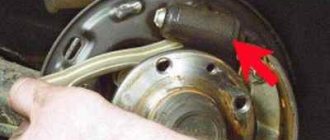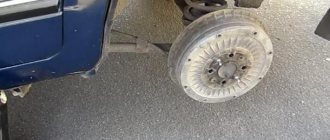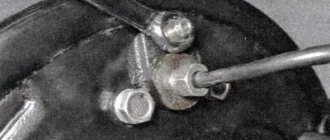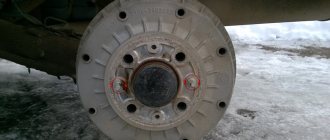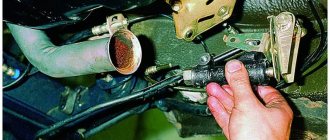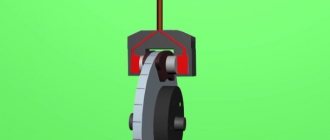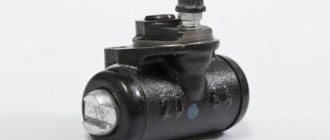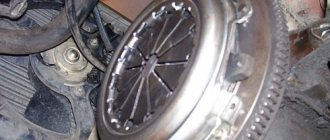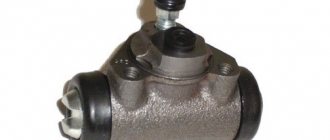Maybe it will be useful to someone
Warning: there will be a lot of text below.
Good day to all of you, dear friends. Although the entry is called “Replacing the rear brake cylinder, rear brake pads and brake drum.”, to be honest, I really wanted to call it something from the series: “The story of how I almost shit myself.” So what I mean is that I decided to change the wheels on my car to winter ones. I’m driving back after changing the wheels, there’s a pedestrian crossing, on the side of the road a girl is about to cross the road, I smoothly press the brake and the pedal gradually sinks to the floor. Subsequent presses - the pedal is on the floor, the car does not brake, the handbrake does not "hello". In general, somehow braking the engine, I roll the bumper to the beginning of the pedestrian crossing and stop. Luckily I was driving slowly. The girl, not suspecting anything, cheerfully crosses the road, and I sit in oh...e. I pulled to the side and looked and the rear left wheel on the inside was all covered in brake fluid. It’s clear that the brake cylinder has broken. How I drove the remaining kilometer to the parking lot, measuring the speeds of all road users so as not to stop, is a completely different story.
After removing the wheel, I realized that it was necessary to change not only the brake cylinder, but also the pads and brake drum.
In the Avtoall.ru store we purchased VAZ-2101-2112 wheel guide clamps 21013101082 - 4 pieces, link to the product: www.avtoall.ru/fiksator_v..._napravlyayushiiy-003580/, price: 9 rubles per piece.
And the following was purchased at the Planetazhelezyaka.rf store:
— Brake drum IZH-2126 IzhAvto OJSC — 1 piece, link to the product: www.planetazhelezyaka.rf/au…chasti-izh-moskvich/81450, price: 1350 (although when I bought it I took it a little cheaper, apparently the price has risen).
— Rear brake cylinder IZH, M-412 FENOX Classic — 1 piece, link to product: www.planetazhelezyaka.rf/au…chasti-izh-moskvich/73066, price: 565 rubles.
— Brake bleeding key 08x10 with 2 clamps — 1 pc., link to product: www.planetazhelezyaka.rf/avto-instrument/247723, price: 110 rubles.
— brake bleeding hose — 4 meters, internal diameter 4 mm (the hose itself is sold as a hose for windshield washer systems)
— M-2140 rear brake pads, which I don’t remember exactly, cost 450 rubles for a set of 4 pieces.
But I remember how I chose it. To avoid mistakes, I used uncle sergio’s post from the topic about rear pads from the 2126.ru forum.
Specifically the post read:
“so, the promised Smile left block -2140, 412, 2126 middle - 2141 right - 2141 with a re-drilled hole for our finger (test) number 1 - different hole diameters number 4 - attempt to enlarge the hole - pay attention to its location, which is different from the desired one number 2 - a protrusion that distinguishes the pads number 3 - for us this hole is mandatory, unlike the 412th, otherwise we will have to drill (Dafmi pads, for example, without it)"
and below is a comparative photograph of the Muscovite brake pads 2140, 2141 and 2141 drilled out for installation on the Izh 2126.
The pads that are installed on the Izh 2126 without modifications are the ones on the left. The number 2 indicates a characteristic protrusion that makes it easy to remember which pads to buy.
The DOT 4 brake fluid was left over from Oda's clutch bleeding.
- loosen the wheel nuts - jack up the car so that the wheel comes off the ground - do NOT
on a jack, the car must be well fixed (in my case, this role was played by the wheels remaining in the cabin after changing shoes)
- completely unscrew the wheel nuts and remove the wheel - unscrew the old wheel guide clamps (studs) - after this, in theory, the drum should come off, but usually this does not happen, since everything has soured and wear has formed in the drum. In this case, we loosen the handbrake by not just lowering it down, but by unscrewing the tension nuts. And gently and carefully tapping in a circle with a hammer, remove the drum.
— then we disassemble the springs and the pads themselves ( Be sure to remember which sides and what the springs are attached to. It’s even better to take pictures from different angles. Incorrect installation of them can cause a grinding noise when driving and incorrect operation of all brakes.
)
-unscrew the handbrake cable fastening
— unscrew the two bolts securing the brake cylinder on the back side of the brake shield. - next is the fun part, we need to unscrew the brake hose from the brake cylinder using the brake bleeder key. Since there was no desire to repair hoses, the hose was unscrewed as carefully as possible. Namely, half a turn with the key, and then we turn the cylinder itself half a turn, that is, we do not turn the fitting, but the cylinder itself, and so on until we unscrew it. - having installed the new cylinder, also turning the cylinder itself, we assemble everything in the reverse order - be careful there are slots on the cylinder rods, the pads themselves should fit into them - if all the springs are put on easily and without force, most likely you made a mistake and did not install them correctly, check and verify everything again with the photographs - it is also important that brake and oil fluid does not get on the friction linings of the brake pads and the braking surface of the drum; if this happens, you need to carefully wipe it with a cloth with gasoline, but it is better not to allow this as this may have an effect on the operation of the entire brake system - difficulties may arise when seating the drum back, that is, the new pads are wider, plus there is no wear out of the drum, if this happens, it is necessary to loosen the handbrake cable as much as possible in order to compress the pads as much as possible: hit the bracket with a hammer in the direction of the brakes, pull lever in the cabin (the cable must be tensioned, that is, the nuts that we loosened are returned to their place) and so on until the desired result is achieved, before installing the drum, the handbrake cable can be loosened back. — after we have assembled everything, it is imperative to bleed the brakes and adjust the handbrake.
What is a brake cylinder and what is its working principle?
The brake cylinder is one of the main elements of the brake system. The rear brake cylinder body is made of alloy. Do not confuse the rear brake cylinder with the master cylinder. The main brake cylinder is designed to convert brake fluid pressure into fluid pressure, and the rear brake cylinder on the wheel is designed to convert brake fluid pressure into brake pressure on the pad. In other words, the rear brake cylinder presses on the pads, thereby stopping the car.
Principle of operation
The main criterion is that all elements of the Lada Kalina braking system must function clearly, which guarantees the safety and reliable braking of the vehicle.
The operating principle of the Lada brake system is as follows. After pressing the brake pedal, the piston begins to move in the cylinder. Fluid from the main exhaust valve enters the Kalina brake system through hydromechanical hoses. The fluid is then directed towards the main wheel mechanism through pipelines, creating the necessary conditions for the movement of the pads to the front wheel disks and to the rear drums. Contact occurs and braking occurs.
Repair work: debugging the brake system
If the following problems are detected, it is recommended to immediately contact a car service to eliminate them.
- Presence of air in the system. You can solve the problem not only with service, but also yourself. To do this, you need to bleed the brakes.
- Brake fluid leaking. This situation indicates a malfunction of pipelines and rubber hoses.
- Increasing pedal stroke. The problem that has arisen indicates a problem with the vacuum booster. It is recommended to replace the hose and check its attachment points.
- Reduced braking efficiency. In this case, the reason may be oily brake linings, jammed cylinder pistons, compromised gasket integrity, or defective adjustment by the regulator.
- Squeaking or vibration when braking. Perhaps the tension spring is weakened, the linings are out of order, or the rubbing linings are oily.
Which brake brake should I choose?
The modern market is full of different types of rear brake cylinders, so when buying this element, it is not easy to make a choice. Numerous reviews on the Internet will help us with this. Having studied the content on this topic, we came to the following conclusion: By and large, all brake cylinders in the same price category have the same quality, but the rear brake cylinder from ATE turned out to be the highest quality and most desirable. Our Basalt, which is one of the best domestic manufacturers of these products, does not lag behind.
It’s only recently that I started making quality products. The Belarusian company fenox, whose products are, to put it mildly, “unreliable,” even wanted to buy it, but they couldn’t buy it. The products also perform well.
Signs of a bad rear brake cylinder.
The first and most important sign of a brake cylinder malfunction is a brake fluid leak. But as a rule, the condition of the rear brake cylinder can be fully assessed when removing the drum, so most often it is changed along with replacing the rear pads (How to replace rear brake pads?) and replacing the handbrake cable, which is not good and is fraught with consequences.
Most often, the pistons in the rear brake cylinders become sour, rubber bands break, and the like. In principle, the brake cylinder can be repaired, but it is better to simply replace it with a new one and not waste a lot of time and effort, since the price for them is not outrageous.
Factors influencing the price level
The caliper can be purchased at different prices. The cost level is affected by the following:
- Condition of the spare part.
- Place of purchase.
- Type of detail.
- Original auto parts.
- The need for delivery (relevant when ordering a part from an online store or purchasing through a private advertisement).
- Brand.
- Seller’s pricing policy (carrying out promotions, sales, providing bonuses to regular customers).
- Use of coupons and promotional codes when placing an order.
How to replace a brake cylinder?
To replace the brake cylinder we will need a jack, wheel wrench, keys, some brake fluid, wd-40.
- First of all, put the car in 1st gear and remove the handbrake.
- We use a balloon to loosen the rear wheel and support the front brakes with “shoes” so that the car does not roll away.
- Place the jack and remove the wheel.
- Unscrew the guide bolts as shown in the figure.
- We try to turn the drum by hand. If this doesn’t work, then take a small sledgehammer and a wooden block and apply the block to the surface of the drum and hit the handle with the sledgehammer. We carry out this operation on the entire surface of the “rim” of the drum until we use our hands to move the drum from its place.
- After turning it 30-40 degrees, screw the guide bolts back into the drum. The purpose of this procedure is to remove the drum.
- After removing the drum, pull the handbrake all the way.
- Then remove the cap of the brake cylinder fitting and use an “8” spanner to unscrew the fitting.
- We carefully treat the brake pipe fitting with wd-40.
- We take the key to “10” and loosen the fitting, after first clamping the tube so that it does not rotate.
- We completely turn out the fitting with the key “10”.
- Using the same key, we unscrew both brake cylinder fasteners.
- We put a rubber cap on the brake fluid pipe.
- We take out the cylinder.
The brake system of the Lada Kalina car
The hydraulic brake system of a VAZ 1118 car consists of a pedal lever, a hydraulic master cylinder, a vacuum brake booster 1118, a hydraulic reservoir, a pressure regulator, a regulator drive lever, pipelines, flexible reinforced rubber hoses, tees, and fastening clamps. At the same time, the brakes on this VAZ model can be equipped with an anti-lock braking system, but it was not installed in the first series of Kalina production. Today, almost the entire line of cars comes with an ABS system.
Replacing the rear brake cylinder.
And so, replacing the rear brake cylinder. One day you wake up in the morning and get ready to go to work in a good mood. You open your garage, where your favorite car is, and drive it out of the garage. As you head towards your garage to close the doors, you notice a wet spot on the floor. You leave for work, but you've been bothered all day by that strange spot on your garage floor. In the evening, having quickly examined the car, you do not notice anything strange, but after waiting for the day off, you drive the car into the inspection pit and begin the examination. After a complete inspection, you notice that the brake fluid level in the reservoir has dropped. When you descend into the viewing hole, the following picture is revealed.
And we immediately understand that the rear brake cylinder needs to be replaced. To replace the brake cylinder, in addition to the usual tool, we will need a special wrench for unscrewing the brake pads.
Next we proceed to replacement.
We jack up the car and remove the wheel. Don't forget to install an additional stop for safety. Remove the brake drum (how to remove the brake drum is described in the corresponding section).
Using a larger screwdriver, remove the brake pads from the lower stops and, lightly pressing on them from above, lower them a little to the bottom so that they release the brake cylinder.
Now we need to unscrew the brake pipe from the cylinder itself. This is where the special key in the photo above comes in handy. With this key we simply rip off the tightened fitting and then unscrew it with a simple key.
When unscrewing, be careful that the fitting does not rotate with the tube, and that you do not accidentally twist the tube. When you unscrew the tube, plug it with a protective cap (from the new brake cylinder) so that the brake fluid does not leak out.
Next, use a regular key to unscrew the two bolts and remove the cylinder itself.
And continuing the topic of replacing the rear brake cylinder, let's talk about the brake cylinder itself.
This cylinder has a built-in system for automatically lining the pads; older models did not have such a system, which added unnecessary hassle with adjustment. I think it’s not worth repairing such brake cylinders; it’s easier to buy new ones.
Next, install the cylinder back and screw on the brake pipe. We put back the pads with the brake drum and screw the wheel. Now all we have to do is bleed the brake system, as described in the corresponding post.
This concludes our article on replacing the rear brake cylinder, and this article will help you replace the cylinder yourself.
Bleeding the hydraulic brakes
We pump the brakes to remove air from the hydraulic drive after it has depressurized when replacing the master cylinder, brake cylinders, hoses, tubes, as well as in case of replacing the working fluid or when the brake pedal becomes “soft”. We remove air from the system when the engine is not running, first from one circuit and then from the other in the following sequence: - the brake mechanism of the right rear wheel; -brake mechanism of the left front wheel; -brake mechanism of the left rear wheel; -brake mechanism of the right front wheel. If air gets into one of the circuits, it is enough to bleed only this circuit, and not the entire hydraulic drive. We bleed the brakes with an assistant. It is more convenient to carry out the work on an inspection ditch or overpass. If the rear wheels are hanging out.
How to remove and install the rear brake cylinder on a VAZ 2114, 2113, 2115
The rear brake cylinder is responsible for effectively braking your car. Therefore, you need to check its operation from time to time. After all, your safety on the road depends on it. It is located under the rear wheel drum. To gain access to it, you need to remove the wheel and pull out the drum.
Selecting a brake cylinder.
Today there are a huge number of manufacturers of spare parts for cars. And it’s easy to get confused when choosing quality spare parts. In order to make a choice, you can read reviews on the Internet. We also read and came to certain conclusions. The most reliable brake cylinder is considered to be the ATE cylinder. The cylinder is also not inferior to it. You can also look at Kraft products.
How to determine a faulty brake cylinder.
The first sign of a problem in the brake system will be a brake fluid leak. You can also evaluate the condition of the cylinders when replacing the rear pads. Usually the rubber bands in the brake cylinders break and the pistons become sour. Of course, they can be repaired, but it is much easier to replace them with new ones, since they are not expensive. In stores you can find cylinders for around 400 rubles.
How the rear brakes of the Kalina work
The rear brake assembly consists of:
- from brake drums;
- two-piston cylinder;
- pads;
- hand brake mechanism;
- “soldiers” holding pads;
- return springs;
- adjusting bolts with eccentrics.
Rear wheel brake
The size of the rear drums on Kalina is 256 mm. This is the outer diameter. But when purchasing a spare part, it is not necessary to know the exact parameters. It is enough to tell the seller the make and model of the car, as well as the year of manufacture. The same information must be provided when ordering parts online.
Replacing the rear brake cylinder.
- The first step is to remove the brake drum.
- Raise the handbrake all the way.
- Remove the cap from the bleeder fitting and use a size 8 wrench to completely unscrew it.
- Lubricate the fitting with grease.
- Loosen the brake pipe fitting.
- We finally unscrew the fitting.
- Unscrew the 2 bolts securing the working cylinder.
- Place the fitting cap on the tube to prevent brake fluid from leaking out.
- Remove the brake cylinder from the shield.
- Before installation, we clean everything from rust and dirt and degrease the working surfaces.
- Reinstall the brake cylinder in reverse order.
- Reinstall the brake drum.
We bleed the brake system and check everything for leaks.
